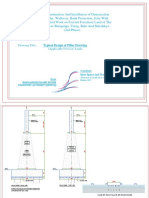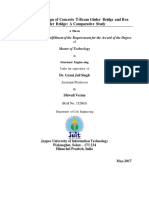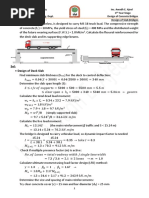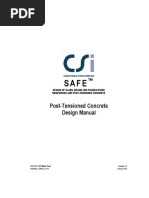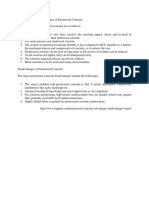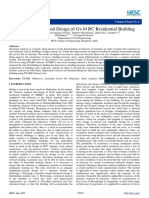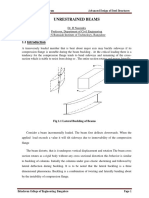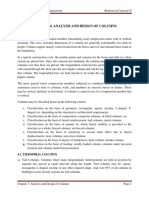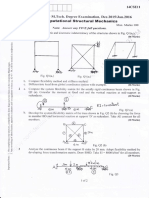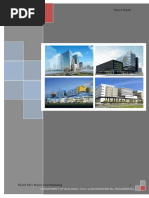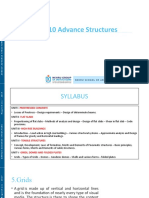Module 2 BEAM COLUMN IN FRAMES PDF
Module 2 BEAM COLUMN IN FRAMES PDF
Uploaded by
karthiksampCopyright:
Available Formats
Module 2 BEAM COLUMN IN FRAMES PDF
Module 2 BEAM COLUMN IN FRAMES PDF
Uploaded by
karthiksampOriginal Title
Copyright
Available Formats
Share this document
Did you find this document useful?
Is this content inappropriate?
Copyright:
Available Formats
Module 2 BEAM COLUMN IN FRAMES PDF
Module 2 BEAM COLUMN IN FRAMES PDF
Uploaded by
karthiksampCopyright:
Available Formats
Faculty Development Program Advanced Design of Steel Structures
Beam Columns in Frames
Dr. Sunil Kumar Tengli
Professor, Dept. of Civil Engineering,
REVA University, Bangalore.
2.1 Beam Column
Columns subjected to combined axial force and bending moment is called as beam
column.
i) A beam column may be subjected to single curvature bending over its length.
Fig 2.1 Beam Column
The Beam column deflects in yz plane only.
ii) In the fixed portal frame shown in Fig 2.2
Fig 2.2 Braced Frame
the rotations of the beams causes rotation of the column, due to rigid connection. The
beam transfers the vertical load to the column along with moments due to flexural rotaion at the
joints. Hence the column is subjected to axial load and bending moment.
Brindavan College of Engineering, Bangalore Page 56
Faculty Development Program Advanced Design of Steel Structures
iii) Consider the Mill Bent ABCDE shown in fig 2.3
Fig 2.3 Mill Bent
This lateral load acting on AB is due to wind or earthquake. This causes bending moment
along with axial force in the columns.
iv) In industrial structures, the gantry girders are supported on brackets which inturn
connected to the columns. Referring to the Fig 2.4; the gantry girder transfers its
reaction ‘P’ at an eccentricity ‘e’. Thus the column is subjected to bending moment in
addition to the axial load ‘P’. In addition the column is subjected to horizontal load
which is called horizontal surge.
Fig 2.4 Transfer of gantry girder to columns
Brindavan College of Engineering, Bangalore Page 57
Faculty Development Program Advanced Design of Steel Structures
v) In case of multistoreyed building frames, the unbraced frame is subjected to vertical
loads (gravity loads) and lateral loads. The columns are subjected to axial load and
bending moments due to lateral sway and bending.
Fig 2.5 Unbraced Frame
vi) If the purlins are placed away from the nodes in case of roof trusses also cause
bending. The net effect in that roof truss members are subjected to axial compression
and bending moments.
Fig 2.6 Purlins are placed between the nodes
vii) In case of Cable stayed bridges and Guyed Towers, the members are subjected to
axial compression and bending.
Brindavan College of Engineering, Bangalore Page 58
Faculty Development Program Advanced Design of Steel Structures
Fig 2.7 Cable Stayed bridge Fig 2.8 Guyed Tower
2.2 Flexural Torsional Buckling
In this case the beam column is not restrained laterally. It may buckle premature out of the plane
bending by deflecting laterally and twisting.
Fig 2.9
The beam column may bent about both the principal axes and twisted.
Fig 2.10
In the above Fig, it causes biaxial bending which involves beam bending, beam twisting and
column buckling.
Brindavan College of Engineering, Bangalore Page 59
Faculty Development Program Advanced Design of Steel Structures
2.3 Axial Load and bending moments
In a multistoreyed building, the frame is subjected to gravity loads and lateral loads. In
such cases, the column is subjected to compression and bending moments.
Fig 2.11
The corner columns in a building frame is subjected to biaxial moment and compression.
The presence of bending moments in the beam columns reduces the axial force at which the
beam column fails.
Fig 2.12
Brindavan College of Engineering, Bangalore Page 60
Faculty Development Program Advanced Design of Steel Structures
2.4 Failure of Beam Columns
Short beam column → Failure is due to material failure
Long Beam column → Failure is due to either material strength or instability of the overall
column.
A short column made up of plastic, compact or semi compact section under axial
compression fails by yielding.
--------------- (1)
Where is the yield strength of the material.
Fig 2.13
In the above beam column, the distribution due to axial compression and due to only
bending moment are drawn. The combined diagram is obtained by superpositions. The combined
stress distribution diagram is split into two stress distribution diagrams which consist of
exclusively moment only and also only due to the axial compression overa finite depth of the
beam.
Fig 2.14
Brindavan College of Engineering, Bangalore Page 61
Faculty Development Program Advanced Design of Steel Structures
The interaction diagram shape can be mathematically expressed as
For small axial compression
then ( ) ----------- (2.1)
When
+ ---------------- (2.2)
2.5 Long Beam Columns
Consider the beam column shown in Fig 2.15 subjected to equal and opposite moment
Mo
Fig 2.15
Beam column bent into a single curvature, with maximum deflection If axial
compression is applied at the ends, additional bending moment is caused due to the axial load
acting on the deformed shape.
Due to P effect, the maximum moment in a beam column Mmax is larger than externally
applied moment Mo.
Consider the load deformation behavior as shown in Fig 2.16
If an axial compression P is initially applied, so that ( ) is maintained constant. While
the moments at two ends of the beam column is increased, the elastic behavior of beam column
is shown in Fig.
Brindavan College of Engineering, Bangalore Page 62
Faculty Development Program Advanced Design of Steel Structures
Fig 2.16
From the above Fig; the stiffness of the beam column i.e, the slope of the moment rotation line
decreases with increases in the initially applied axial compression.
On the other hand, if ( ) is maintained constant, and the axial compression is
increased, the compressive load versus lateral deformation is non linear.
Fig 2.17
Brindavan College of Engineering, Bangalore Page 63
Faculty Development Program Advanced Design of Steel Structures
It is to be noted that the end moments modify the behavior of an axially loaded column in a way
similar to the initial bow type of imperfections.
It is to be remembered that in the first order linear elastic analysis, the additional
moments due to P and P effects, do not have any effect as the equilibrium equations are
derived from the undeformed structure, OA in Fig ( ) Vs ( ) shows the linear relationship.
In nonlinear analysis, the bending effects are magnified by P - ∆, and P – effects as the
load increases. The nonlinear variation of maximum bending moment Mmax due to increase in
load P acting at constant eccentricity ( = constant ) is shown by the curve OB.
Fig 2.18
If (P – (P - ∆) were not considered then compressive strength is Fo.
Actual compressive strength is Fci due to the maximum effect.
The corresponding moment in linear analysis is Mo.
Actual magnified moment M max.
Brindavan College of Engineering, Bangalore Page 64
Faculty Development Program Advanced Design of Steel Structures
Fig 2.19
Magnified deflections and bending moments (M max) are obtained from
Mmax =
PE is the Euler buckling load
It is observed from the above equations that as P approaches PE , both and M max increases
rapidly and tends to approach infinity.
It indicates that if Mo is very small, as P approaches PE failure is eminent.
Brindavan College of Engineering, Bangalore Page 65
Faculty Development Program Advanced Design of Steel Structures
Moment gradient in beam columns.
Due to application of moments in addition to axial load the column buckles in single
curvature or double curvature depending on the ratio of M1 and M2 applied at the top and bottom.
The ratios of ( M1/M2) can be +1, ˂ 1, 0, -1 respectively. Consequently the member strength are
due to the above moment gradients. This is illustrated in the following figures.
Fig 2.20 Moment gradient in beam columns
Brindavan College of Engineering, Bangalore Page 66
Faculty Development Program Advanced Design of Steel Structures
Note:-
i) The column subjected to end moments causing single curvature is weaker than the
same column subjected to end moments in double curvature.
ii) In addition to end moments, the column is subjected to wind loads. This also to be
taken into account in design.
iii) In IS 800; Cm refers to the moment gradient, known as uniform moment factor.
iv) The code gives
Cm = 0.6 + 0.4 ψ
In case (a) ; ψ = 1 and Cm = 1
In case (d) ; ψ = -1 and Cm = 0.2
But Cm ≥ 0.4 as per code.
Hence minimum value of Cm = 0.4 In the interaction equations;
+ kz ≤ 1.0
Cm appears in the numerator. Hence the fourth case where ψ = -1 is less severe when
compared with the first case i.e. when ψ = +1.
2.6 Behavior of Column at Ultimate load
When the eccentricity of the applied compression is equal to zero , the beam column
becomes axially loaded compression member.
When the eccentricity of the applied compression is very large, the beam column tends to
behave like a beam, since axial compression effect is negligible.
Thus there are two extreme limits i.e., between column and beam. Thus a range of
combination of beam column exists. Hence beam column exhibit various combinations of
buckling and plastic failures depending on the relative values of axial force, moment, buckling
strength and bending strength of the member.
The bending may be about minor axis only, causing flexural failure.
The flexural yielding may be about major axis only, causing Torsional flexural buckling
or a combination of bending moments about both the axis.
Brindavan College of Engineering, Bangalore Page 67
Faculty Development Program Advanced Design of Steel Structures
Fig 2.21 : Minor Axis Bending
Fig 2.22 : Major Axis Bending
Brindavan College of Engineering, Bangalore Page 68
Faculty Development Program Advanced Design of Steel Structures
2.7 Effects of Slenderness ratio and axial force modes of failure
Beam columns may fail by flexural yielding or torsional flexural buckling. The mode of
failure would depend on the magnitude of axial load, eccentricity and the slenderness ratio.
2.8 Beam column having lower slenderness ratio. ( l / r < 50 )
Fig 2.23 Beam – Column Moment Rotation Behaviour
The moment curvature relationship may be linear or non linear depending on whether the
axial force is applied first followed by bending moment or both of them increased
proportionately. The deformation is only the plane of bending. At the penultimate stage, yielding
of the compression flange occurs first and spreads through the section on further loading.
Under proportional loading, the loading path is increased by OAB. There is a small
reduction in the moment capacity below M px due to the presence of axial compression in the
member. There would be further reduction in the moment beyond point A with increasing end
rotation, due to the spread of plasticity from the end section.
Brindavan College of Engineering, Bangalore Page 69
Faculty Development Program Advanced Design of Steel Structures
2.9 Beam column having higher slenderness ratio. ( l / r < 80 )
A more slender column, under small axial compression combined with end moments
would fail by buckling out of the plane of the bending moment.
If the bending is predominant, lateral buckling of compression flange as in unrestrained
beams occurs. The axial force would cause minor axis to deform and hence failure can be minor
axis bending and twisting ( OC ' ). The moments being below the full in plane strength.
Fig 2.24
2.10 High axial load ratio (
Beams columns having lower slenderness ratio ( < 50 ).
High axial load ratio ( )
Beam columns having high axial load combined with bending moment, yielding can
occur over larger segment of the member due to combined axial stress, bending stress and
residual stress. Due to single curvature bending deflection caused by equal moments,
Brindavan College of Engineering, Bangalore Page 70
Faculty Development Program Advanced Design of Steel Structures
Fig 2.25
Moment magnification occurs at mid length.
The main difference in the behavior of stocky beam column under axial compression, compared
to smaller axial compression are the moment magnification, large reduction in moment capacity
due to axial compression and drastic unloading in the penultimate stage ( EF in Fig)
2.11 Beam columns having a high slenderness ratio ( l / r ˃ 80 )
In slender beam columns with larger axial load , the P – effect is larger both in plane of
and out of plane of the moment. In longer beam columns, the moment may drop drastically when
yielding starts under axial compression and magnified moment ( OEF ' ). It is to be mentioned
here that out of plane deformation could occur earlier than that corresponding to the section
under axial force and magnified moment ODF''.
Brindavan College of Engineering, Bangalore Page 71
Faculty Development Program Advanced Design of Steel Structures
Fig 2.26
Thus the design of beam columns having high slenderness ratio requires the investigation of in
plane bending failure by flexural yielding and out of plane.
2.12 Beam Column under Biaxial Bending
The ultimate behaviour of beam-columns under biaxial bending is effected by the effect of
plastification of moment magnification and lateral Torsional buckling. Typical failure envelope
is
Fig 2.27
Brindavan College of Engineering, Bangalore Page 72
Faculty Development Program Advanced Design of Steel Structures
Shown in Fig. It is seen that with increase in the slenderness ratio, it reduces the strength of the
member except in the case of purely bending about the week axis.
For very small axial force ranges, increases in axial compression tend to decrease the bending
strength about the axes.
2.13 Design procedure for Beam-columns.
1) The factored loads and moments are determined.
2) A trial section is assumed to start with.
3) The section is classified. Plastic and compact sections are preferred over semi compact
sections as latter fail by yielding.
4) The most heavily loaded section is checked for the following.
α1 α2
+ ≤ 1.0 for plastic and compact sections.
≤ 1.0 for semi compact sections.
My, Mz Factored applied moments about the minor and major axis.
Nd is the design tensile strength.
Mdy, Mdz are the design buckling strength of member.
5) The member is checked for its bending resistance in compression.
6) The member is checked for buckling resistance in bending.
7) The lateral Torsional buckling moment is determined by any one of the following equations.
Mcr=C1 )
(or)
Mcγ=βbzpfcr1b
Where
Fcr1b =
(or) by
Mcr =C1
Brindavan College of Engineering, Bangalore Page 73
Faculty Development Program Advanced Design of Steel Structures
Where C1 is a factor to account for different loading and support conditions.
8) Using the calculated value of Mcr
The design bending stress and design bending strength can be determined,
Mdz ≥ Mz
9) The member is checked for overall resistance for combined bending and axial compression
using interaction equations.
Brindavan College of Engineering, Bangalore Page 74
Faculty Development Program Advanced Design of Steel Structures
2.14 Numerical Examples
Example 2.1
A column ISHB 300@630 N/m in a framed building supports spandrel beams. The beams are
welded to the column flanges and transfer end reactions of 200 kN (beam1) and 400 kN (beam 2)
and an axial compression force of 750 kN. From the top storeys. Check the adequacy of the
column. If it’s effective length is 3.0 meters. The beam reactions and the equivalent design
forces.
Solution
Total maximum axial load = 750+200+400=1350kN
Total maximum bending moment = )X10-3=30kNm
Section classification
= 11.79 ˂ 15.7
= 27.32 ˂ 84
Section is “semi compact”.
Check for local capacity of the section,
Factored axial compressive load =N=1350kN
Factored Bending moment Mz = 22.5kNm
Design compressive strength due to yielding
Nd = Ag = 8025X X10-3
Nd = 1823.86 kN
Design bending strength under moment acting along Z axis.
Mdz = βb Zpz = Zpz (
Mdz = Zez = 863.3X103 X 10-3 mm3 x
Mdz = 196.2(103)Nmm
Brindavan College of Engineering, Bangalore Page 75
Faculty Development Program Advanced Design of Steel Structures
Mdz = 196.2 kNm
≤ 1.0
= 0.89 ≤ 1.0
Check for member buckling resistance in compression
= = 1.2
And tf = 10.6 mm ≤ 100 mm
= 56.71
λ fcd
50 183
60 168
fcd =183- x 6.71 = 172.94 N/ mm2
Design compressive strength = fcd A = 172.94 x = 1387.85 kN ˃ 1350 kN ok
Also in the other direction;
= = 23.62
λ fcd
20 224
23.62 ?
30 211
fcd = 224 – x 13 = 219.23 N / mm2
Design compressive strength = 219.29 x = 1759.8 kN ˃ 1350 kN
Brindavan College of Engineering, Bangalore Page 76
Faculty Development Program Advanced Design of Steel Structures
Check for member buckling resistance in bending,
Lateral torsional buckling moment
Mcr=C1 )
For uniform moment C1 = 1.0
Effective span = 3000mm
Elastic modulus E = 2X105 N/mm2
Shear modulus G = 76.92X103 N/mm2
St Venant’s Constant = ∑ = It
=2 + (h-tf)
=2 x 250 x + (300-10.6) x
St venant’s constant It = 27.7 (10)4 mm4
Iw = Warping constant = (1-βf) βf Iy hf2
hf = c\c distance between flanges = 300-10.6 = 289.4 mm
βf = = 0.5
Iw = (1-0.5) 0.5 x 2246.7 x 104 x 289.42
Iw = 4.7 x1011 mm4
Mcr =
Mcr =
Mcr = 7.82 (10)9 N mm
Non dimensional slenderness ratio
β
λLT =
Brindavan College of Engineering, Bangalore Page 77
Faculty Development Program Advanced Design of Steel Structures
λLT =
= 0.166
ᶲLT = 0.5[1+αLT (λLT -0.2) + λ2LT]
ᶲLT = 0.5[1+0.21 (0.166 -0.2) + 0.1662]
ᶲLT = 0.51
χLT =
λ
χLT =
χLT = 1.0078
Design Bending stress= χLT
= 1.0078 X
= 229N/mm2
Design Bending Capacity= βb
=1x863.3x103x229x10-6
=197.7KNm > 30KNm (Factored design bending moment)
Check for overall member buckling resistance for combined
Ref Eq 9.3.2.2, Pg 71, IS 800
1.0
Brindavan College of Engineering, Bangalore Page 78
Faculty Development Program Advanced Design of Steel Structures
As My is Zero;
1.0
P=1350KN
Pdz=1759.8KN
Kz= 1+(λz-0.2) 1+0.8
λz= Non dimensional slenderness ratio
λz =
fcr1z=
fcr1z=
fcr1z= 3538.09N/mm2
λz =
λz = 0.2658
Kz= 1+(0.2658-0.2)x
Kz= 1.05
It should be less than 1.0+0.8 x
= 1.61
Equivalent uniform moment factor
Cmz = 0.6+0.4ψ
Ψ= = 1.0
Brindavan College of Engineering, Bangalore Page 79
Faculty Development Program Advanced Design of Steel Structures
Cmz = 0.6+0.4x1.0 = 1.0> 0.4
Therefore substituting in the above equation
< 1.0
= 0.9 ≤ 1.0
Brindavan College of Engineering, Bangalore Page 80
Faculty Development Program Advanced Design of Steel Structures
Example 2.2
A column in a building is fixed at the bottom and top end is hinged. Design the column due to a
reaction of 600KN from the beam at an eccentricity of 150mm from the major axis of the
section. The height of the column is 4m.
Solution:-
Axial load = 600KN = 600 X 103 N
Bending moment = P X e = 600 X 150 = 90 X 106 Nmm
Assume a design compressive stress of 80MPa
Therefore, area required = 600 X 103 / 80 = 7500mm2
The overall section is semi compact.
Section strength as governed by material failure (clause 9.3, P70)
Axial stress = (N/Ag) = (600 X 103/8025) = 74.77N/mm2
Bending stress = (Mz/Ze) = (90 X 106/863.3 X 103) = 104.25N/mm2
The fixed end moment at the bottom is half of the bending moment at the top.
Hence HB = ((MA+MB)/l) = ((90+45)/4) = 33.75KN
Shearing strength of section
Vd ={(Fy/√3) (htw/1.10)}
= {(250/√3)(300 X 9.4/1.10)} = 370KN
V/Vd = (33.75/370) = 0.09<0.6 reduction in moment capacity need not to be done.
Refer cl 9.3.1.3 P71
Fx = (N/Ag) + (Mz/Ze) =179.02N/mm2
& (N/Nd) +(My/Mdy) +(Mz/Mdz) ≤1.0
Nd = (Agfy /rmo) = ((8025 X 250)/(1.1 X 1000)) = 1823.9KN
Mdz = Ze fbd
fbd is obtained from table13(a) from table 14
(kl / ryy) = (0.8 X 4000/52.9) = 60.5
Brindavan College of Engineering, Bangalore Page 81
Faculty Development Program Advanced Design of Steel Structures
h / bf = 300/10.6 = 28.30
From table 14; = 669 MPa
From Table 13(a);
Fbd = 197.7 –(69/100) X 4.6 = 194.5 MPa
Mdz = 863.3 X 103 X (194.5/100) = 167.97 KNm
Substituting in the interaction action
(600/1823.9) + (90/167.97) = 0.86< 1 OK
Member strength as governed by buckling failure ( cl 9.3.2 P71)
+ Kz Cmz ≤ 1.0
All the section is semi compact; Mdz = Zefbd
Mdz = ZeχLT fy / γmo
χLT = 1 / (ΦLT + [ - ]0.5 ≤ 1.0
λz = = = 0.61 > 0.4
Evaluation of i.e buckling @ yy axis
h / bf = 300/250 = 1.2 from table10; P44
buckling about yy axis id ‘C’
tf = 10.6mm < 100mm; Therefore buckling about zz is ‘b’
= 60.5; Table 9( c) ; = 168 N/mm2
= 8025 X 168 X 10-3 = 1348.2KN
Evaluation of for buckling about zz axis
= 3200/127 = 25.2
Table 9 (b) ; fcd = (225+216)/2 = 220.5 MPa
Brindavan College of Engineering, Bangalore Page 82
Faculty Development Program Advanced Design of Steel Structures
= 8025 X 225 X 10-3 = 1769.5 KN
Kz = 1 + (λz – 0.2)nz
λz =
= 3200/127 = 25.2
= 28.30
Refer table 14, P57 – IS 800
= 3990 N/mm2
λz = = 0.25
nz = = 600/1348.2 = 0.445
ny = = 600/1769.5 = 0.339
Kz = 1 + (λz – 0.2)nz = 1 + (0.25 – 0.2) 0.445 = 1.01 < 1.24 OK
Ψ = ratio of minimum to maximum BM
Ψ = -45/90 = -0.5
Cmz = 0.6 + 0.4 Ψ = 0.4
CmLT = 0.4 ( Table18, P72, IS800:2007)
KLT = 1 – ( 0.1 λLT ny) / (CmLT -0.25)
= 1 – {(0.1 X 0.61 X 0.339)/(0.4-0.25)} = 0.86
+ KLT = (600/1769.5) + (0.86 X 91/169.7) = 0.8 <1 OK
+ Kz Cmz = (600/1769.5) + (1.01 X 0.4 X 90/169.7) = 0.55 < 1 OK
Hence use ISHB300
Brindavan College of Engineering, Bangalore Page 83
You might also like
- Case Study On Diff SettlementDocument22 pagesCase Study On Diff Settlementsravyasai13100% (1)
- Column Designs Calculation Excel FileDocument45 pagesColumn Designs Calculation Excel FileFarukNo ratings yet
- Biwta Pilar Double Pile - 07.02.2019Document6 pagesBiwta Pilar Double Pile - 07.02.2019mehediNo ratings yet
- 1.BEAM TO BEAM CONNECTION-BOLTS 1RV17CV134-Model - MergedDocument14 pages1.BEAM TO BEAM CONNECTION-BOLTS 1RV17CV134-Model - MergedFAHD ABDUL RAHMANNo ratings yet
- Pile Foundation For BridgesDocument9 pagesPile Foundation For BridgesDharma banothuNo ratings yet
- Bridge PDFDocument57 pagesBridge PDFudaynarayanaNo ratings yet
- Static Analysis On Tied Arch BridgeDocument7 pagesStatic Analysis On Tied Arch BridgeIJRASETPublicationsNo ratings yet
- Finite Element Analysis of Skew Curved RC Box Girder BridgeDocument8 pagesFinite Element Analysis of Skew Curved RC Box Girder BridgeTran Tien DungNo ratings yet
- 18CV821 Design of Bridges Cie 2Document1 page18CV821 Design of Bridges Cie 2mohan hsNo ratings yet
- Vertical Parabolic CurveDocument5 pagesVertical Parabolic CurveHarvey Jusay CarableNo ratings yet
- Prestressed ConcreteDocument123 pagesPrestressed ConcreteArunavNo ratings yet
- BridgeDocument58 pagesBridgeIyœ Møsisæ100% (2)
- Losses in PrestressDocument38 pagesLosses in PrestressKausalya PurushothamanNo ratings yet
- Design Project On Multi-Story Building Design Using Reinforced ConcreteDocument1 pageDesign Project On Multi-Story Building Design Using Reinforced ConcretecrazyNo ratings yet
- Advanced Structural Analysis Prof. Devdas Menon Department of Civil Engineering Indian Institute of Technology, Madras Module No. # 1.3 Lecture No. # 03 Review of Basic Structural Analysis - 1Document32 pagesAdvanced Structural Analysis Prof. Devdas Menon Department of Civil Engineering Indian Institute of Technology, Madras Module No. # 1.3 Lecture No. # 03 Review of Basic Structural Analysis - 1MananshNo ratings yet
- Balanced Cantilever BridgeDocument4 pagesBalanced Cantilever Bridgesushant metriNo ratings yet
- Bridge ComponentsDocument58 pagesBridge Componentsradhakrishnang100% (1)
- List of Forces To Be Considered While Designing A Well Foundation Are As Follow1Document2 pagesList of Forces To Be Considered While Designing A Well Foundation Are As Follow1jagadeshNo ratings yet
- Bridge Engg Box Pipe CulvertsDocument19 pagesBridge Engg Box Pipe Culvertsashish jain100% (1)
- Effect of Varying Slab Depth of The Skew CulvertDocument12 pagesEffect of Varying Slab Depth of The Skew CulvertIJRASETPublicationsNo ratings yet
- Paper On Floating ColumnDocument8 pagesPaper On Floating Columnমোঃ হাসান ইমামNo ratings yet
- 5th Sem & 6th Sem Syllabus KukDocument31 pages5th Sem & 6th Sem Syllabus KukvivekNo ratings yet
- ST7006-Design of Bridges PDFDocument9 pagesST7006-Design of Bridges PDFmiestyNo ratings yet
- 4 Design of Slab Bridges PDFDocument6 pages4 Design of Slab Bridges PDFsohanpmeharwadeNo ratings yet
- Loading On Road Bridges (As Per IRC 6) - Excl. LLDocument76 pagesLoading On Road Bridges (As Per IRC 6) - Excl. LLarunkumar.mgsNo ratings yet
- Safe PT DesignDocument407 pagesSafe PT DesignĐậuĐìnhHùngNo ratings yet
- Mace 60035Document7 pagesMace 60035eng_ayman_H_MNo ratings yet
- A Case Study On Inelastic Seismic Analysis of Six Storey RC BuildingDocument6 pagesA Case Study On Inelastic Seismic Analysis of Six Storey RC BuildingFreedom of speech100% (1)
- Paper No. 609Document15 pagesPaper No. 609ravi kumarNo ratings yet
- Deformed Shape: Load Case/ Load Combination / Modal CaseDocument4 pagesDeformed Shape: Load Case/ Load Combination / Modal CasesovannchhoemNo ratings yet
- 6.7.2 Steel Girder CamberDocument3 pages6.7.2 Steel Girder CamberaomareltayebNo ratings yet
- Note On Stability of StructuresDocument6 pagesNote On Stability of Structurespanos2244662864100% (1)
- Advantages and Disadvantages of Prestressed ConcreteDocument1 pageAdvantages and Disadvantages of Prestressed ConcreteMarlou Salazar SabanganNo ratings yet
- Geotechnical Engineering Made Easy Handwritten Classroom NotesPart-1Document63 pagesGeotechnical Engineering Made Easy Handwritten Classroom NotesPart-1Ipsita MuduliNo ratings yet
- Deflection and Frequency in Different LoadingDocument2 pagesDeflection and Frequency in Different LoadingAnkuran SahaNo ratings yet
- Cold Formed Steel DesignDocument9 pagesCold Formed Steel DesignMNo ratings yet
- Amendment No. 1 November 2014 TO Is 4326: 2013 Earthquake Resistant Design and Construction of Buildings - Code of PracticeDocument9 pagesAmendment No. 1 November 2014 TO Is 4326: 2013 Earthquake Resistant Design and Construction of Buildings - Code of PracticeAKSNo ratings yet
- 2019 MIDAS Civil Price ListDocument1 page2019 MIDAS Civil Price ListGoutam MandalNo ratings yet
- Static and Dynamic Performance of Tall Bridge Abutments With Counterfort ConfigurationDocument11 pagesStatic and Dynamic Performance of Tall Bridge Abutments With Counterfort ConfigurationSm ConsultantsNo ratings yet
- Footing Calculation PDFDocument10 pagesFooting Calculation PDFVaishak KrishnanNo ratings yet
- Benkelman Beam Deflection For Flexible Road PavementDocument4 pagesBenkelman Beam Deflection For Flexible Road PavementInternational Journal of Innovative Science and Research TechnologyNo ratings yet
- Structural Dynamics NotesDocument42 pagesStructural Dynamics Notesrajivkannan100% (1)
- IS 800 Amendment No:1Document5 pagesIS 800 Amendment No:1mohan1441No ratings yet
- TR 334 Tutorial-1Document5 pagesTR 334 Tutorial-1Adaminovic MrishoNo ratings yet
- Assesment and Restoration of Heritage and Historic Structures Affected by The Bhuj, India Earthquake of 2001Document13 pagesAssesment and Restoration of Heritage and Historic Structures Affected by The Bhuj, India Earthquake of 2001Smriti SNo ratings yet
- .Seismic Analysis and Design of G+10 RC Residential BuildingDocument9 pages.Seismic Analysis and Design of G+10 RC Residential BuildingAlphaone HammadNo ratings yet
- Introduction To Bridge Engineering: Presentation Created by David Garber (Assistant Professor, FIU)Document26 pagesIntroduction To Bridge Engineering: Presentation Created by David Garber (Assistant Professor, FIU)Saurabh SinghNo ratings yet
- Bridge Report Last YearDocument288 pagesBridge Report Last Yearpantheesarwagya23No ratings yet
- AbstractDocument5 pagesAbstractSyed Azeem0% (1)
- Solid Slab Bridge Design Example 39 2015 - 1-3Document3 pagesSolid Slab Bridge Design Example 39 2015 - 1-3Hamlity SaintataNo ratings yet
- Aashto LRFD Bridge Design 1Document50 pagesAashto LRFD Bridge Design 1asinahu farhanNo ratings yet
- Draft Rank 2019Document71 pagesDraft Rank 2019tirursachinNo ratings yet
- IRC-112-2011 - 2019-10 - Amendment 8Document7 pagesIRC-112-2011 - 2019-10 - Amendment 8AnoopNo ratings yet
- Unit-2 FLEXUREDocument49 pagesUnit-2 FLEXURENicholas ThompsonNo ratings yet
- Module 1 UNRESTRAINED BEAMSDocument55 pagesModule 1 UNRESTRAINED BEAMSkarthiksampNo ratings yet
- Column Design Note According To ECS, 2015Document35 pagesColumn Design Note According To ECS, 2015Khalid CaliNo ratings yet
- RC II - chapter-4-LNDocument67 pagesRC II - chapter-4-LNFenta NebiyouNo ratings yet
- Reinforced Concrete Structures IIDocument81 pagesReinforced Concrete Structures IItomasabdeta5No ratings yet
- Lecture 4 Columns DesignDocument33 pagesLecture 4 Columns DesignOlesea NesterencoNo ratings yet
- Unrestrained Beam Design-IiDocument21 pagesUnrestrained Beam Design-Iihemant_durgawaleNo ratings yet
- MoehlesmrfDocument33 pagesMoehlesmrfalinajiattiyahNo ratings yet
- 3rdunit Earthquake 170128045752Document26 pages3rdunit Earthquake 170128045752karthiksampNo ratings yet
- Redecon 2022 BrochureDocument4 pagesRedecon 2022 BrochurekarthiksampNo ratings yet
- Flyer of BIS Webinar On Diaster Resilient InfrastructureDocument3 pagesFlyer of BIS Webinar On Diaster Resilient InfrastructurekarthiksampNo ratings yet
- Glass in BuildingDocument18 pagesGlass in BuildingkarthiksampNo ratings yet
- Combined FootingDocument14 pagesCombined FootingkarthiksampNo ratings yet
- Comparative Study of RC Multi-Storey Building Subjected To Elevated Temperature For Different StoreysDocument31 pagesComparative Study of RC Multi-Storey Building Subjected To Elevated Temperature For Different StoreyskarthiksampNo ratings yet
- 2022 Uttara Ashadha Nakshatra Dates Uttara AshaDocument1 page2022 Uttara Ashadha Nakshatra Dates Uttara AshakarthiksampNo ratings yet
- Design of Isolated FootingDocument366 pagesDesign of Isolated FootingkarthiksampNo ratings yet
- Ultimate Flexural Strength of Singly Reinforced Rectangular SectionsDocument9 pagesUltimate Flexural Strength of Singly Reinforced Rectangular SectionskarthiksampNo ratings yet
- 10cv321intrdn 170212171800 PDFDocument136 pages10cv321intrdn 170212171800 PDFkarthiksampNo ratings yet
- Rubrics For Projects For PresentationDocument22 pagesRubrics For Projects For PresentationkarthiksampNo ratings yet
- Experimental Study On Flexural Behaviour of Reinforced Geopolymer Concrete Beam With Steel FiberDocument43 pagesExperimental Study On Flexural Behaviour of Reinforced Geopolymer Concrete Beam With Steel Fiberkarthiksamp100% (1)
- Design of Reinforced Concrete StructureDocument83 pagesDesign of Reinforced Concrete StructurekarthiksampNo ratings yet
- Design of Reinforced Concrete StructureDocument44 pagesDesign of Reinforced Concrete StructurekarthiksampNo ratings yet
- Vaastu Shastra Utilisation of Ancient in PDFDocument6 pagesVaastu Shastra Utilisation of Ancient in PDFkarthiksampNo ratings yet
- Concrete Mix Design DOE PDFDocument15 pagesConcrete Mix Design DOE PDFkarthiksamp100% (2)
- Module-2 (Singly Reinforced-Beam)Document41 pagesModule-2 (Singly Reinforced-Beam)karthiksampNo ratings yet
- Of Structures: Design and Drawing T/ Hrs. Part-A 1 Oj Psrt-&. 'E X" .-EDocument2 pagesOf Structures: Design and Drawing T/ Hrs. Part-A 1 Oj Psrt-&. 'E X" .-EkarthiksampNo ratings yet
- Essentials For Durable ConcreteDocument40 pagesEssentials For Durable ConcretekarthiksampNo ratings yet
- Design and Drawing: of StructuresDocument2 pagesDesign and Drawing: of StructureskarthiksampNo ratings yet
- Design: and Drawing of StructuresDocument2 pagesDesign: and Drawing of StructureskarthiksampNo ratings yet
- 2.ii':: JKFL/ :,:F !:# :!.'""': of StructuresDocument2 pages2.ii':: JKFL/ :,:F !:# :!.'""': of StructureskarthiksampNo ratings yet
- Design and Drawing HRS.: of StructuresDocument2 pagesDesign and Drawing HRS.: of StructureskarthiksampNo ratings yet
- dl1377 PDFDocument2 pagesdl1377 PDFkarthiksampNo ratings yet
- AF, L/yl.o: S Rav @/aDocument2 pagesAF, L/yl.o: S Rav @/akarthiksampNo ratings yet
- Ffiffire: Gomputational MechanicsDocument3 pagesFfiffire: Gomputational MechanicskarthiksampNo ratings yet
- Design of Shear Connection Between Beam To Beam:: As Per AISC 13 Edition (ASD)Document13 pagesDesign of Shear Connection Between Beam To Beam:: As Per AISC 13 Edition (ASD)rohitnrg0% (1)
- Design of Isolated Foundation - 18Document1 pageDesign of Isolated Foundation - 18Srinivasa RaoNo ratings yet
- Question (1) : Draw The B.M.D. For The Following Frame Using The Consistence Deformation Method. Knowing That E 2000 T/CM, I 30000 CM, and A 20 CMDocument11 pagesQuestion (1) : Draw The B.M.D. For The Following Frame Using The Consistence Deformation Method. Knowing That E 2000 T/CM, I 30000 CM, and A 20 CMMahmoud AhmedNo ratings yet
- Change of Items in BOQ - IIMADocument1 pageChange of Items in BOQ - IIMAjswldeepNo ratings yet
- Form Work StairsDocument142 pagesForm Work StairsAlex AlmNo ratings yet
- Design of Canal Lining SystemDocument23 pagesDesign of Canal Lining SystemChamil Mahagamage100% (1)
- 2012 Design Calculations Roof UnitsDocument25 pages2012 Design Calculations Roof UnitsmabuhamdNo ratings yet
- Mathcad - 06. Analysis of T BeamDocument3 pagesMathcad - 06. Analysis of T BeamMrAlittle FingerNo ratings yet
- Concrete Beam Rebar Table (Seismic) : CC1 CC2 CC3 CC4 Concrete Column ScheduleDocument1 pageConcrete Beam Rebar Table (Seismic) : CC1 CC2 CC3 CC4 Concrete Column Schedulesikandar abbasNo ratings yet
- Statement of Construction MethodDocument35 pagesStatement of Construction MethodKhetab Ahmed 1825376060No ratings yet
- Balsa Bridge - Tension - CompressionDocument27 pagesBalsa Bridge - Tension - CompressionAhmed MohamedNo ratings yet
- Performance Based Seismic Design of Reinforced Concrete Tall BuildingsDocument175 pagesPerformance Based Seismic Design of Reinforced Concrete Tall BuildingsPatrick Canceran100% (1)
- Design of Composite Precast BeamDocument47 pagesDesign of Composite Precast BeamfarahazuraNo ratings yet
- Masonry: Construction Method and Project ManagementDocument43 pagesMasonry: Construction Method and Project ManagementJQNo ratings yet
- Estimation of A Office BuildingDocument65 pagesEstimation of A Office BuildingKuldipBadwal100% (1)
- 03 30 00 - Cast in Place Concrete PDFDocument17 pages03 30 00 - Cast in Place Concrete PDFsyedNo ratings yet
- Analysis ReportDocument40 pagesAnalysis ReportRoman BaralNo ratings yet
- Displacement Method of Analysis: Slope Deflection EquationsDocument87 pagesDisplacement Method of Analysis: Slope Deflection EquationsParikshith PrasadNo ratings yet
- Structural Steel in Housing Connection Examples - OS20 PDFDocument6 pagesStructural Steel in Housing Connection Examples - OS20 PDFMuriungi RicharsNo ratings yet
- AR6010 Unit 5 (DOME SHELL GRID ROOF)Document27 pagesAR6010 Unit 5 (DOME SHELL GRID ROOF)vgdarchNo ratings yet
- WELL FOUNDATION - IIT RoorkiDocument28 pagesWELL FOUNDATION - IIT RoorkiMahesh KalyanshettiNo ratings yet
- Behavior and Design of HSC Members Subjected To Axial Compression and FlexureDocument28 pagesBehavior and Design of HSC Members Subjected To Axial Compression and FlexurengodangquangNo ratings yet
- Materials in Construction PDFDocument20 pagesMaterials in Construction PDFGhiovani DayananNo ratings yet
- Lecture39-Seismic Response of PilesDocument34 pagesLecture39-Seismic Response of PilesArun Goyal100% (1)
- Steel Plate GirderDocument108 pagesSteel Plate GirderAngelina Winda0% (1)
- Proposed-Two-Storey-Resort-Structural-Analysis (1) DDocument26 pagesProposed-Two-Storey-Resort-Structural-Analysis (1) DIver Ace BihisNo ratings yet
- Civil Engineering Drawing: An Introduction To Drawing - IIDocument23 pagesCivil Engineering Drawing: An Introduction To Drawing - IIKamal UddinNo ratings yet
- Reinforced BESSER™ Block Retaining WallsDocument16 pagesReinforced BESSER™ Block Retaining WallsromamanNo ratings yet


